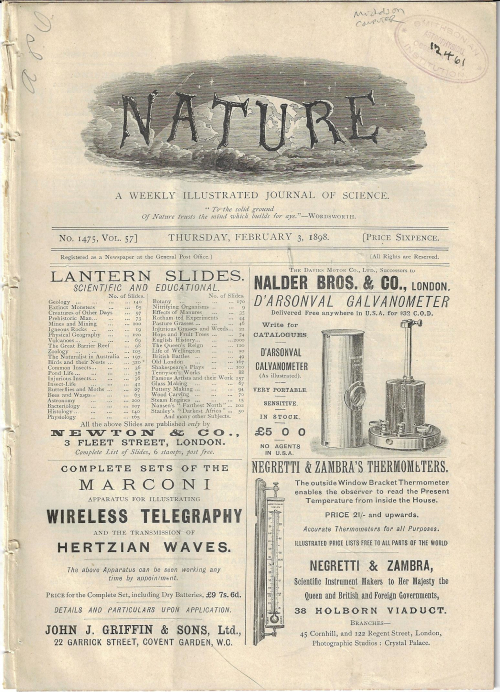[MICHELSON, A.A.] Appearance in the review/scientific serials section of Nature, February 3, 1898. Referencing the harmonic analyzer of Michelson. This appears as one paragraph on page 333. Pp 313-336. With the original wrappers. This issue is removed from a larger bound volume. Provenance: Smithsonian Astrophysical Laboratory. Good solid copy. $125
 The full statement on Michelson: “SCIENTIFIC SERIALS: American Journal of Science, January. A new harmonic analyser by AA Michelson and SW Stroud. This is an instrument designed to sum up as many as eighty terms of a Fourier series or to analyse a given curve into its original series. The pen which traces the curve is worked up and down by a lever controlled by a spring. This spring is stretched by an ecentric which imparts a simple harmonic variation to the force. The stretching is resisted by another spring. Eighty such elements are connected together with one resisting spring to counterbalance the sum of the elementary springs. The pen therefore moves in accordance with the sum of the elementary periodic motions. The authors obtain by this machine the mathematical series representing the profile of a human face.”
The full statement on Michelson: “SCIENTIFIC SERIALS: American Journal of Science, January. A new harmonic analyser by AA Michelson and SW Stroud. This is an instrument designed to sum up as many as eighty terms of a Fourier series or to analyse a given curve into its original series. The pen which traces the curve is worked up and down by a lever controlled by a spring. This spring is stretched by an ecentric which imparts a simple harmonic variation to the force. The stretching is resisted by another spring. Eighty such elements are connected together with one resisting spring to counterbalance the sum of the elementary springs. The pen therefore moves in accordance with the sum of the elementary periodic motions. The authors obtain by this machine the mathematical series representing the profile of a human face.”
From the blurb on the book about the Michelson Harmonic Analyzer: “Many famous machines have been built to do math -- like Babbage’s Difference Engine for solving polynomials or Leibniz’s Stepped Reckoner for multiplying and dividing -- yet none worked as well as Albert Michelson’s harmonic analyzer. This 19th century mechanical marvel does Fourier analysis: it can find the frequency components of a signal using only gears, springs and levers. We discovered this long-forgotten machine locked in a glass case at the University of Illinois... by Bill Hammack, Steve Kranz and Bruce Carpenter.”--via theengineerguy.com website.




Comments